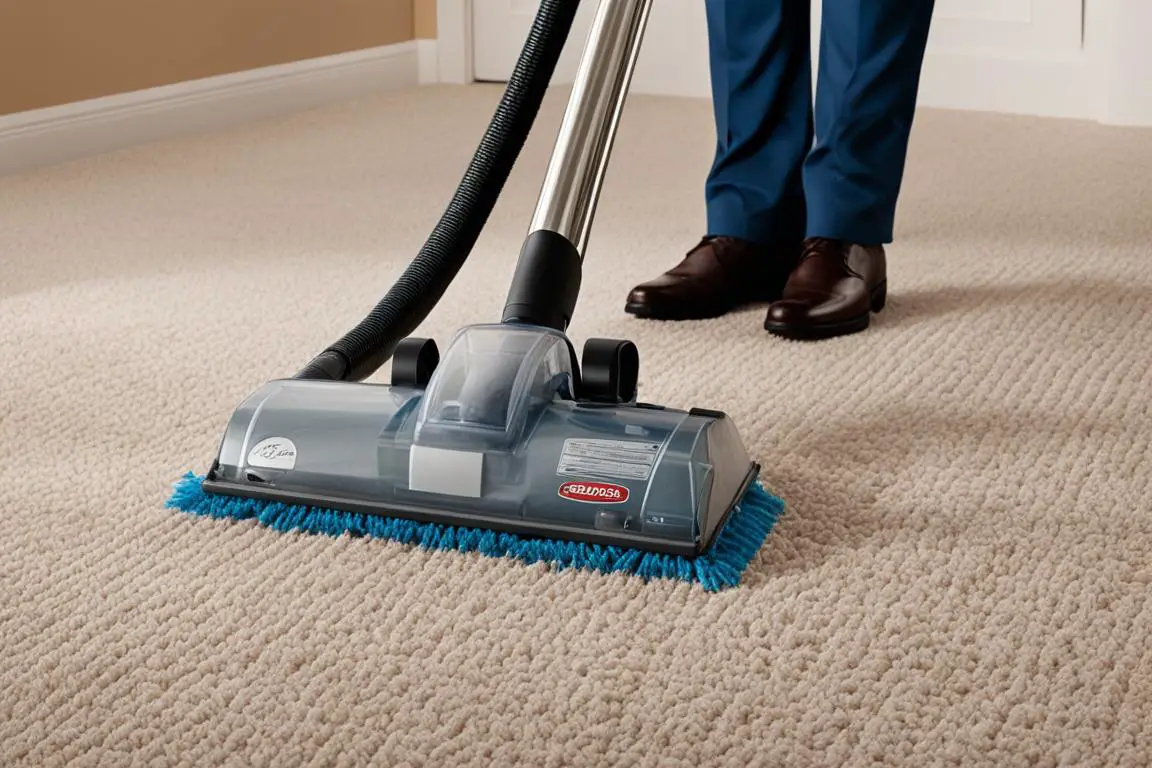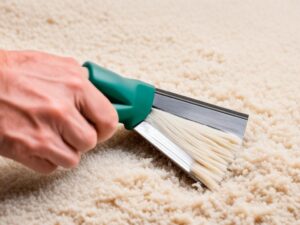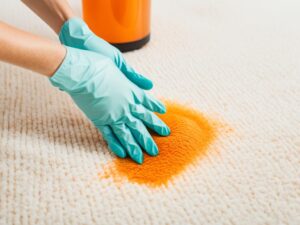Carpet shampooing is an essential part of maintaining the cleanliness and freshness of your carpets. However, the rinsing process after shampooing is equally important to ensure that all residue and cleaning agents are thoroughly removed from the carpet fibers. In this guide, we will provide you with step-by-step instructions and valuable tips on how to rinse your carpet effectively after shampooing, along with the best carpet rinsing techniques and post-shampoo care.
Key Takeaways:
- Proper carpet rinsing is crucial for maintaining the cleanliness and freshness of your carpets.
- Follow the step-by-step instructions to rinse your carpet effectively after shampooing.
- Choose the appropriate carpet rinsing technique based on your carpet’s material and condition.
- Regular carpet maintenance is essential to prolong the lifespan of your carpets and keep them looking their best.
- Consider hiring a professional carpet cleaning service for larger areas or heavily soiled carpets.
Why Shampooing and Rinsing Carpets is Important
Regular vacuuming may not remove all dirt, grime, and stains from carpet fibers. That’s why carpet shampooing and rinsing are important to penetrate deeper and remove tough stains, spills, and odors. Shampooing and rinsing carpets can provide several benefits and play a vital role in maintaining a clean and healthy home environment.
One of the key benefits of carpet shampooing is its ability to improve indoor air quality. Over time, carpets can accumulate dust, pollen, pet dander, and other allergens, which can affect the air you breathe. Shampooing and rinsing the carpets helps to remove these particles, ensuring fresher and cleaner air in your home.
In addition, carpet shampooing and rinsing can help reduce allergens that can trigger respiratory problems and allergies. By deep cleaning the carpet fibers, you can eliminate the buildup of dust mites and pet allergens, making your home a healthier and safer space for everyone, especially those with allergies or asthma.
Furthermore, regular carpet shampooing and rinsing can extend the lifespan of your carpets. Dirt and debris can build up over time, causing wear and tear on the carpet fibers. By removing these particles through proper shampooing and rinsing, you can preserve the integrity and appearance of your carpets, resulting in a longer lifespan and saving you money in the long run.
When it comes to carpet cleaning, proper rinsing is essential. Leaving shampoo residue on the carpet can attract more dirt and make it harder to clean in the future. That’s why it’s crucial to follow carpet cleaning rinse tips to achieve the best results and ensure a thorough clean.
| Benefits of Carpet Shampooing and Rinsing |
|---|
| Improved indoor air quality |
| Reduction of allergens |
| Extended lifespan of carpets |
Proper carpet cleaning rinse tips:
- Thoroughly vacuum the carpet before shampooing to remove loose dirt and debris.
- Follow the manufacturer’s instructions for the appropriate cleaning solution and technique.
- Avoid over-wetting the carpet to prevent damage and promote faster drying.
- Rinse the carpet thoroughly to remove all shampoo residue.
- Ensure proper ventilation during and after the rinsing process to facilitate drying.
By understanding the benefits of carpet shampooing and rinsing, as well as following proper carpet cleaning rinse tips, you can maintain a cleaner, healthier, and longer-lasting carpet in your home.
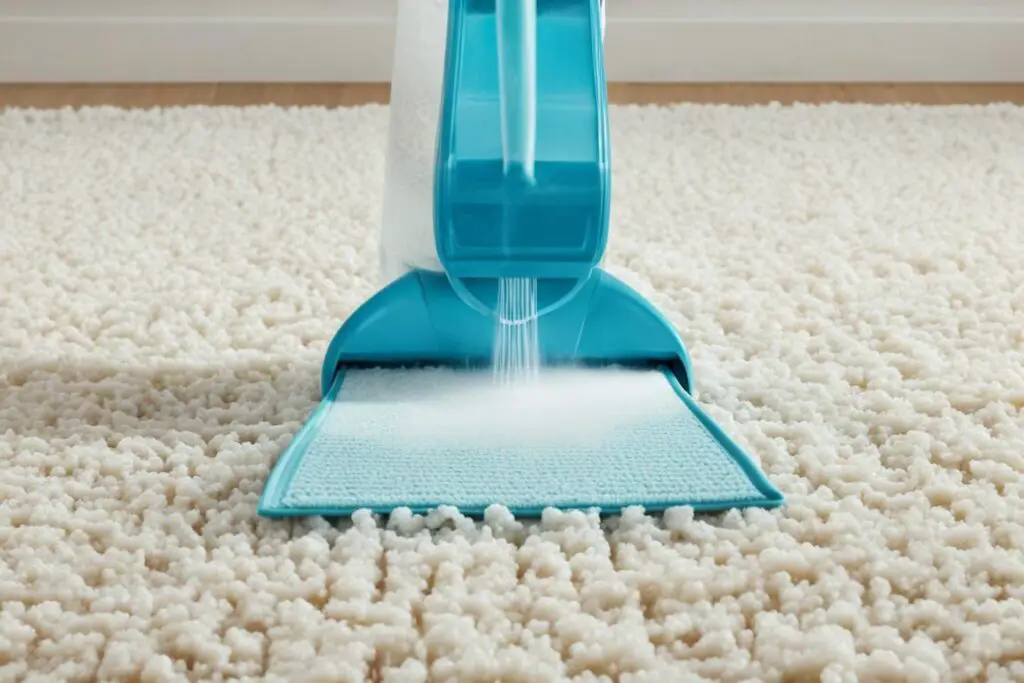
Materials and Tools Needed for Carpet Rinsing
When it comes to effectively rinsing your carpet after shampooing, having the right materials and tools is essential. These items will help you achieve a thorough and effective carpet rinse, leaving your carpets looking and feeling fresh.
- Vacuum cleaner: This is the first tool you’ll need to remove loose dirt and debris from the carpet before rinsing.
- Carpet cleaning machine: Investing in a quality carpet cleaning machine will provide a deep and thorough clean.
- Cleaning solution: Choose a carpet rinse solution that is specifically formulated for deep cleaning and removing stains.
- Pretreatment stain remover: For stubborn stains, use a pretreatment stain remover before rinsing to ensure maximum results.
- Clean white cloth: This cloth will come in handy for blotting and drying the carpet during the rinsing process.
- Oscillating or box fan: A fan will help speed up the drying process by promoting airflow and preventing mold or mildew growth.
If you want to enhance your carpet rinse, there are optional ingredients you can add:
- Baking soda: Sprinkling baking soda on the carpet before rinsing can help eliminate odors.
- Salt: Salt can be used to absorb fresh spills and lift stains from the carpet fibers.
- Scrub brush: A scrub brush can assist in agitating the cleaning solution and loosening dirt and grime from the carpet.
- White vinegar: Mixing white vinegar with water can be an effective DIY carpet rinse solution.
- Spray bottle: A spray bottle is useful for applying the cleaning solution evenly on the carpet.
- Microfiber cloth: This cloth is gentle on the carpet fibers and can be used for spot cleaning or wiping any excess moisture.
With these carpet rinsing materials and tools, you’ll be well-equipped to tackle any carpet cleaning task.
Steps to Rinse Your Carpet After Shampooing
Now that you have shampooed your carpet, it’s time to move on to the rinsing process. Proper carpet rinsing is crucial to ensure that all the shampoo and residue are thoroughly removed, leaving your carpet fresh and clean. Here are the steps you need to follow for effective carpet rinsing:
- Move furniture: Before you begin rinsing your carpet, make sure to remove any furniture or obstacles from the area. This will allow you to have clear access to the entire carpet surface.
- Vacuum the carpet: Start by vacuuming the carpet to remove any loose dirt, debris, or remaining shampoo. This step will prepare your carpet for the rinsing process.
- Pretreat stains: Take a close look at your carpet and identify any stubborn stains that need extra attention. Treat these stains with a suitable stain remover before proceeding with the rinsing process.
- Select the right rinsing method: Depending on your preference and the equipment you have available, you can choose between using a steam cleaner or opting for DIY methods. Both methods can be effective, so choose the one that suits your needs and follow the manufacturer’s instructions if using a steam cleaner.
- Begin the rinsing process: Whether you are using a steam cleaner or DIY methods, make sure to thoroughly rinse the entire carpet, working in small sections at a time. Ensure that the rinsing solution reaches the deep layers of the carpet to remove all the shampoo and residue.
After completing the rinsing process, it is important to allow your carpet to dry completely before moving furniture back onto it. This will prevent any moisture-related issues and ensure the longevity of your carpet.
Tip: To expedite the drying process, you can use an oscillating or box fan to increase airflow in the room. This will help in moisture evaporation and prevent any potential mold or mildew growth.
Now that you have successfully rinsed your carpet, it’s time to focus on post-shampoo carpet maintenance to extend its cleanliness and freshness.
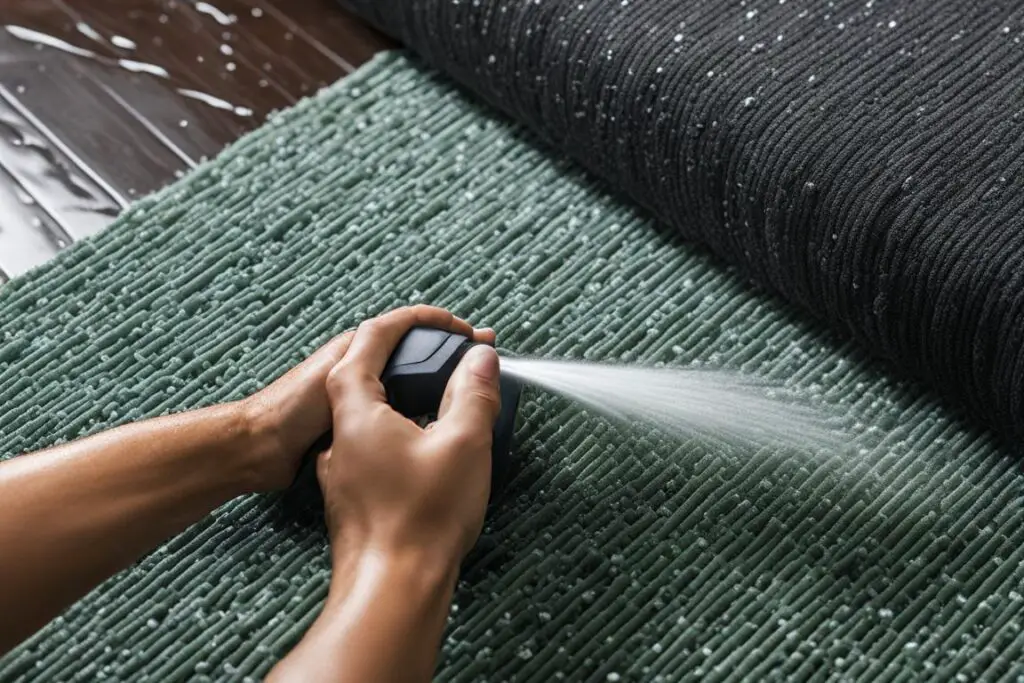
Post-Shampoo Carpet Maintenance
Proper post-shampoo carpet maintenance is essential to keep your carpet in the best possible condition. Here are some key maintenance tips to follow:
- Regularly vacuum the carpet to remove surface dirt and prevent it from settling deep into the carpet fibers.
- Place doormats or area rugs in high-traffic areas to minimize dirt and debris from being tracked onto the carpet.
- Blot spills immediately with a clean white cloth or paper towels to prevent them from saturating into the carpet and causing permanent stains.
- Schedule professional carpet cleaning at least once a year to deep clean and remove any embedded dirt and allergens.
Following these post-shampoo carpet maintenance tips will help you keep your carpet looking and feeling fresh for years to come.
| Methods | Pros | Cons |
|---|---|---|
| Steam Cleaner |
|
|
| DIY Methods |
|
|
Professional Carpet Rinsing vs. DIY Carpet Rinsing
When it comes to rinsing your carpet after shampooing, you have two options: hiring a professional carpet cleaner or tackling the task yourself. Both approaches have their pros and cons, so it’s important to consider your specific needs and circumstances before making a decision.
Professional Carpet Cleaning
Opting for professional carpet cleaning services offers several advantages. First and foremost, hiring professionals saves you time and effort. Trained technicians have the expertise and equipment to deep clean your carpets efficiently, especially in larger areas or if your carpets are heavily soiled.
Professional carpet cleaners use powerful cleaning solutions and advanced techniques to remove stubborn stains, dirt, and allergens effectively. Their thorough cleaning process can restore the appearance of your carpets and improve indoor air quality in your home.
Furthermore, professional carpet cleaning offers convenience. You can schedule an appointment at your preferred time, and the cleaning team will handle the rest. This is especially beneficial for busy individuals or those who prefer to leave the job to experts.
DIY Carpet Rinsing
On the other hand, if you enjoy taking on household tasks and have the time and dedication, DIY carpet rinsing may be a viable option for you. Doing it yourself allows you to save money on professional cleaning services and gives you control over the process.
DIY carpet rinsing requires using your own equipment or renting a carpet cleaning machine. While this may involve extra effort, it allows you to decide which cleaning solution to use and how thorough you want the cleaning to be.
However, it’s important to note that DIY carpet rinsing may not achieve the same level of cleaning as professional services. It requires proper technique and understanding of the equipment to avoid over-wetting or damaging your carpets. Additionally, the results may vary based on the tools and solutions used.
Consider the Pros and Cons
When deciding between professional carpet rinsing and DIY carpet rinsing, consider the following factors:
- Hiring a professional carpet cleaner:
- Saves time and effort
- Thorough and efficient cleaning
- Improves indoor air quality
- Convenience and flexibility
- DIY carpet rinsing:
- Cost-effective
- Provides control over the process
- Allows customization of cleaning solutions
Ultimately, the decision between hiring a professional carpet cleaner and DIY carpet rinsing depends on your budget, time availability, and desired level of cleanliness. If you have large areas or heavily soiled carpets, hiring a professional may be the most efficient option. However, if you enjoy handling tasks yourself and want to save money, DIY carpet rinsing can be a rewarding approach.
Remember that effective carpet rinsing is crucial for maintaining the cleanliness and longevity of your carpets. Whichever option you choose, ensure you follow proper techniques and practices to achieve the best results.
Tips for Proper Carpet Rinsing
To achieve effective carpet rinsing after shampooing, it is important to follow some best practices and tips. By implementing these strategies, you can ensure that your carpets are thoroughly cleaned and maintain their pristine condition.
Thoroughly Vacuum Before Rinsing
Before rinsing your carpet, it is crucial to thoroughly vacuum the area. This step helps to remove loose dirt, dust, and debris, making the rinsing process more effective. Be sure to pay attention to corners, edges, and hard-to-reach areas where dirt may accumulate.
Pretreat Stains
If you have any stubborn stains on your carpet, it is recommended to pretreat them before the rinsing process. Use a suitable stain remover or a homemade solution to target the stains directly. Follow the instructions provided and allow the pretreatment to work its magic for the specified amount of time.
Use the Right Cleaning Solution
Choosing the appropriate cleaning solution is essential for effective carpet rinsing. Select a product that is specifically designed for carpet cleaning and follows the manufacturer’s instructions for dilution ratios. Avoid using excessive amounts of cleaning solution, as it can leave residue on the carpet.
Follow Manufacturer’s Instructions
Whether you are using a professional carpet cleaning machine or a DIY method, it is important to carefully follow the manufacturer’s instructions. This includes recommendations for water temperature, cleaning techniques, and the proper use of the equipment. Adhering to these instructions will help ensure optimal results and prevent any damage to your carpets.
Allow Carpet to Dry Completely
After rinsing, it is crucial to allow your carpet to dry completely before placing any furniture back on it. Damp carpets can easily attract dirt and bacteria, leading to potential odors and staining. Use a fan or open windows to facilitate the drying process and avoid walking on the carpet until it is fully dry.
Summary
By incorporating these best practices and tips into your carpet rinsing routine, you can achieve effective and thorough cleaning results. Remember to thoroughly vacuum, pretreat stains, use the right cleaning solution, follow manufacturer’s instructions, and allow the carpet to dry completely. Following these steps will help maintain the longevity, cleanliness, and freshness of your carpets.
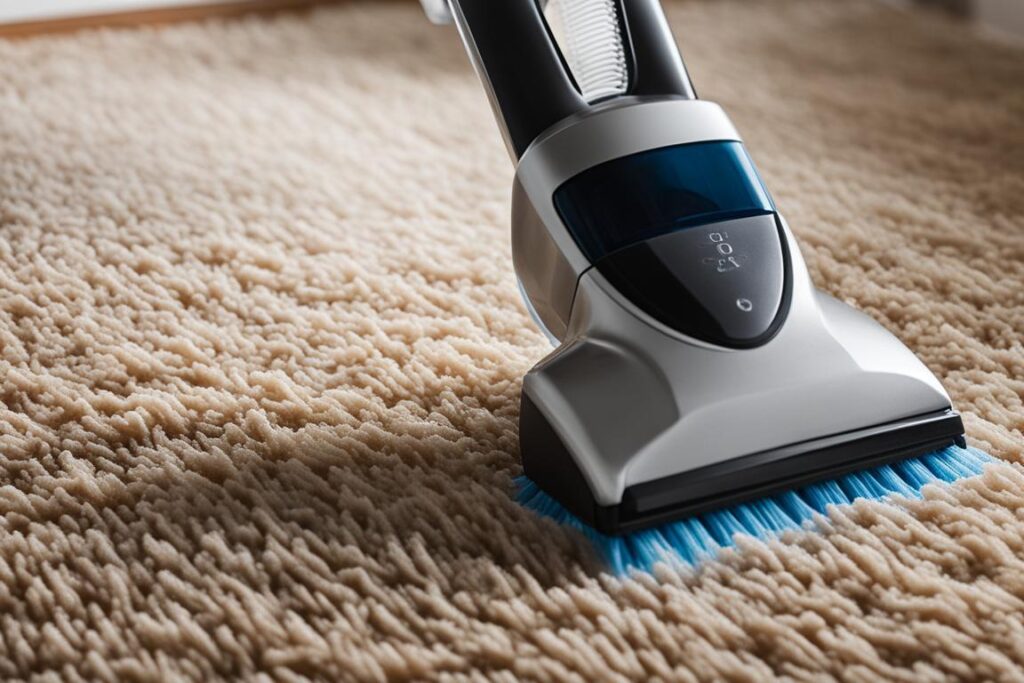
| Best Practices for Carpet Rinsing | Benefits |
|---|---|
| Thoroughly vacuum before rinsing | Removes loose dirt and debris for more effective cleaning |
| Pretreat stains | Target stubborn stains for better cleaning results |
| Use the right cleaning solution | Avoid residue buildup and achieve optimal cleaning |
| Follow manufacturer’s instructions | Prevents damage and ensures safe and effective cleaning |
| Allow carpet to dry completely | Avoid odors, staining, and bacterial growth |
Importance of Regular Carpet Maintenance
Regular carpet maintenance is essential for extending the lifespan of your carpets and keeping them clean and fresh. By incorporating a few simple tips into your routine, you can ensure that your carpets remain in top condition for years to come.
- Vacuum regularly: Regular vacuuming is key to removing surface dirt, dust, and debris from your carpets. Aim to vacuum at least once a week, or more frequently in high-traffic areas.
- Treat stains promptly: Accidents happen, and when they do, it’s important to act quickly. Promptly treating stains with appropriate stain removers can prevent them from setting and becoming permanent.
- Utilize doormats or area rugs: Placing doormats at entrances and using area rugs in high-traffic areas can help minimize dirt and debris from being tracked onto your carpets, reducing the need for extensive cleaning.
- Schedule professional carpet cleaning: While regular vacuuming and spot cleaning are important, scheduling professional carpet cleaning at least once a year is recommended. Professional cleaners have the expertise and equipment to reach deep into the carpet fibers and remove embedded dirt and grime.
Following these tips for carpet maintenance after shampooing will not only keep your carpets looking their best but also contribute to a cleaner and healthier indoor environment for you and your family. So make regular carpet cleaning and maintenance a priority to enjoy beautiful, fresh carpets year-round.
Stay tuned for the final section of our comprehensive guide, where we’ll provide a conclusion and summarize the key takeaways from this series on effective carpet rinsing and maintenance.
Conclusion
Proper carpet rinsing after shampooing is crucial to maintain the cleanliness and freshness of your carpets. By following the right techniques, using the appropriate materials and tools, and practicing regular carpet maintenance, you can ensure that your carpets remain in the best possible condition.
Remember to choose the method that suits your needs and follow the guidelines for effective and thorough carpet rinsing. Vacuuming the carpet before rinsing, pretreating stains, using the right cleaning solution, and allowing the carpet to dry completely are all essential steps in the process.
Additionally, regular carpet maintenance such as vacuuming, treating stains promptly, and scheduling professional carpet cleaning if needed will help extend the lifespan of your carpets and keep them looking and smelling fresh.
By giving your carpets the care they deserve, you can enjoy a clean and healthy living environment while preserving the beauty and longevity of your carpets for years to come.
FAQ
Why is carpet shampooing and rinsing important?
Carpet shampooing and rinsing penetrate deeper into carpet fibers to remove tough stains, spills, and odors. It can improve indoor air quality, reduce allergens, and extend the lifespan of your carpets.
What materials and tools do I need for carpet rinsing?
You will need a vacuum cleaner, carpet cleaning machine, cleaning solution, pretreatment stain remover, clean white cloth, oscillating or box fan, and optional ingredients like baking soda, salt, scrub brush, white vinegar, spray bottle, and microfiber cloth.
What are the steps to rinse my carpet after shampooing?
The steps involve moving furniture, vacuuming the carpet, pretreating stains, and selecting the right method for rinsing. These steps help ensure effective and thorough carpet rinsing.
Should I hire a professional carpet cleaning service or do it myself?
Hiring a professional can save time and ensure thorough cleaning, especially for larger areas or heavily soiled carpets. DIY carpet rinsing can be more cost-effective but requires more time and effort.
What are some tips for proper carpet rinsing?
Thoroughly vacuum before rinsing, pretreat stains, use the right cleaning solution, follow the manufacturer’s instructions for the carpet cleaning machine, ensure proper water temperature, and allow the carpet to dry completely before placing furniture back on it.
Why is regular carpet maintenance important?
Regular carpet maintenance, such as vacuuming regularly, treating stains promptly, using doormats or area rugs in high-traffic areas, and scheduling professional carpet cleaning if needed, is crucial for extending the lifespan and maintaining the cleanliness of your carpets.
